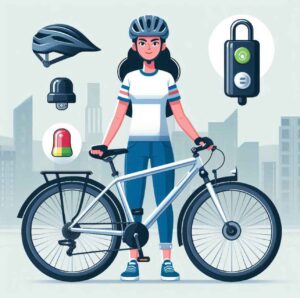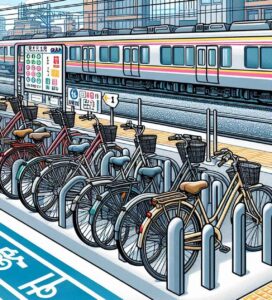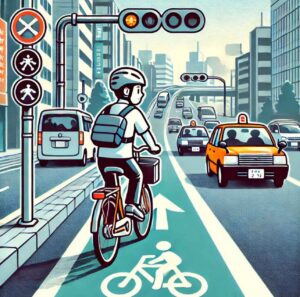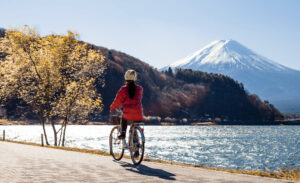Welcome Blessings!
(Tap 🔽 to see more topics!)


Imagine cycling through Tokyo, seeing neon lights, ancient shrines, and the sounds and smells of the city around you. One minute, you’re zipping past skyscrapers. The next, you discover a tiny, inviting ramen shop down a quiet alley. It’s a fantastic way to see the city – up close, at your speed.
Or picture yourself in Kyoto. It’s a slower pace, and peaceful paths are lined with traditional houses and hidden tea shops. There’s just the gentle hum of your bike and the rustling leaves. The air smells of cherry blossoms or autumn leaves. Every corner is a picture, a temple, a stone bridge, and a beautiful river. It’s like riding through a postcard.
Then there’s Nagano. Mountains and valleys, quiet country roads, lush greenery, and stunning views of snow-capped peaks in the Japanese Alps. Nature takes center stage here, a world away from the busy cities.
Japan is a cyclist’s paradise, from the energy of Tokyo and Osaka to the peaceful countryside. You can bike past rice fields, explore historic areas, or enjoy the natural beauty of Nagano.
But the thing is, in Japan, bikes are considered vehicles. You have to follow the same traffic laws as cars. Knowing the rules is important so you can stay safe and avoid any trouble. This article will cover everything you need to know about biking in Japan, whether in Tokyo or Nagano.
Before you set off on your bike and hit the road in Japan, there are some indispensable things you need to consider and take care of. These include:
1. Register Your Bike (Jitensha Toroku)
In Japan, you must register your bicycle with the local authorities. This process, called “Jitensha Bouhan Toroku” (Bicycle Anti-Theft Registration), is designed to deter theft and help track stolen bikes. It is like a license plate for your car, except it is much simpler and cheaper!
If you’re renting a bike, the shop typically handles this for you, so no worries!
Cycling Tip: If you sell or give away your bike, transfer the registration to the new owner to avoid issues.
2. Essential Gear
What must you have on your bike? Japanese cycling laws require you to equip your bike with certain safety features. Missing any of these could result in a fine or put you at risk.
Legally Required Gear:
Optional but recommended gear:
3. Know Where to Ride?
Road Rules:
Exceptions: Children under 13, seniors over 70, and those with disabilities can legally ride on sidewalks.
Never ride against traffic! Even though it might seem convenient, this is illegal and highly dangerous.
Cycling Tip: Be cautious when cycling on narrow or busy roads, and yield to cars and pedestrians as needed.
4. Choose the Right Bike for Your Trip
Your choice of bike depends on your plans:

To keep yourself and others safe, below are some essential rules to follow:
5. Do Follow Traffic Laws
Cyclists in Japan must obey all traffic signals, just like motorists. Running a red light can result in fines and, more importantly, danger!
Watch what local cyclists do if you’re at an intersection and unsure whether you should go or stop.
6. Don’t Cycle Under the Influence
Think you can grab a few beers and ride home? Think again! Cycling under the influence is illegal in Japan and can result in heavy fines or even jail time. Remember, riding a bike under the influence of alcohol is prohibited and carries heavy penalties, including fines of 1 million yen or even imprisonment! Japan takes this very seriously, so if you’ve had a drink, take a train or taxi instead.
7. Parking Your Bike Properly
Japan takes bicycle parking seriously. Leaving your bike in a no-parking zone can be impounded, and retrieving it will cost you.
Safe places to park:
Cycling Tip: If you’re unsure whether parking is allowed, look for a “No Bicycle Parking” sign (駐輪禁止).
8. Dealing with Bike Theft
Is it that safe? Japan is generally safe, but bike theft still happens. To prevent it:
Cycling Tip: Some cities offer free bike registration lookup services. If your bike goes missing, check with the local police station.
9. Don’t Use Your Phone While Riding
It’s illegal to text, call, or browse while cycling. Using headphones is also discouraged, as it reduces awareness of your surroundings. Japan has strict laws against multitasking while riding. That means:
Cycling Tip: If you need to check directions, stop your bike and move to a safe area.
10. Yield to Pedestrians
Pedestrians always have the right of way. If you’re cycling on a sidewalk (only allowed in designated areas), keep your speed low and give way to walkers.
11. Hand Signals Matter
Japanese drivers appreciate predictability, so use hand signals when turning or stopping. It helps prevent accidents and ensures a smoother ride.

12. Finding Bike Parking
Bikes parked in unauthorized areas can be impounded, and retrieving them is a hassle. Look for designated bike parking lots, which are often found near train stations and shopping centers.
13. Weather Surprises
Japan’s weather can be unpredictable. Carry a lightweight rain jacket and consider fenders for rainy days. In summer, hydration is key, always bring a water bottle.
14. Dealing with Hills
Japan isn’t all flat roads! If you’re cycling in hilly areas like Nagano or Hakone, consider renting an e-bike to make those inclines easier.
15. Uncover Hidden Gems
Cycling allows you to explore places off the beaten path. You might stumble upon a tiny ramen shop with the best broth you’ve ever tasted or a secluded cherry blossom spot without the crowds.
16. A Budget-Friendly Way to Travel
Cycling is a cost-effective way to see Japan compared to train fares. Many cities offer affordable bike rentals; some hotels even provide complimentary bicycles.
17. A Healthier and Greener Choice
Cycling isn’t just great for your wallet; it’s also good for your health and the environment. You burn calories while reducing your carbon footprint, which is a win-win!

While the information in our article is generally accurate and reflects everyday experiences here in Japan, it’s always a good idea to do further research before cycling in any new location. Specific road closures, local regulations, and conditions can change. Checking local cycling maps, online forums, and travel blogs can be helpful. And, of course, always using common sense and prioritizing safety is essential.
Cycling in Japan is an incredible way to experience the country up close. Your two-wheeled adventure will be fantastic if you follow the rules, stay respectful, and ride safely. Whether cycling through historic temples or exploring the neon-lit streets, Japan has something special waiting for you! Grab your helmet, hop on your bike, and enjoy the ride!
I hope this article has helped you. If you have any questions or comments, feel free to leave them below. Thanks for joining us today! Voila! Until next time!